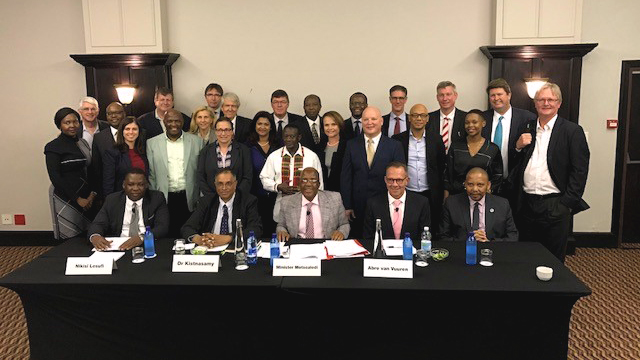
Attorney Mike Elsner (back, second from right) with co-counsel Richard Spoor (far right), South African Minister of Health Aaron Motsoaledi (center seat), Gold Mine Company Officers and Directors and respondents’ lawyers after signing the historic settlement agreement for South African gold workers’ class action today in Johannesburg.
A settlement agreement has been reached in historic litigation for classes of potentially thousands of South African gold miners and the dependents of workers who developed or will develop tuberculosis and silicosis caused by exposure to silica dust while working in the gold mines. The settlement is the result of years of litigation and negotiations among lawyers and consultants Richard Spoor Inc., Motley Rice LLC, Abrahams Kiewitz Inc., Hausfeld, LLP the Legal Resources Centre; the Occupational Lung Disease Working Group, representing the respondents: African Rainbow Minerals, Anglo American SA, AngloGold Ashanti, Gold Fields, Harmony and Sibanye Stillwater. The Settlement will be presented to the Court in South Africa for approval and members of the class and interested parties will be provided notice of the Agreements in advance of the approval process.
South Africa human rights lawyer Richard Spoor, of the Law Office of Richard Spoor Inc., retained U.S. plaintiffs’ law firm Motley Rice LLC to consult on the litigation in 2011.
This is the very first class action settlement of its kind in South Africa. The agreement creates a Trust to compensate all eligible workers suffering from silicosis and/or tuberculosis who worked in these Companies’ mines from 1965 to date as well as their dependents. The settlement includes a significant budget for the Trust to locate potential class members, medically examine eligible miners and provide compensation to all qualifying class members. The settlement is not a limited fund or fixed amount. The Companies have agreed to compensate all eligible Claimants.
“I am pleased with this settlement. We have managed to provide access to justice and meaningful compensation to thousands of current and former gold mine workers and their dependents spread throughout Sub-Saharan Africa,” said Motley Rice attorney Michael Elsner who has been a consultant in the South Africa litigation since the beginning and was one of the lead settlement negotiators. “This agreement is proof that when opposing counsel are willing to listen, work together and think creatively, significant public good can be achieved. In this case, we could not have accomplished these results in a trial judgment. It is a credit to the lawyers working on behalf of the settling companies and the class.”
Read the specifics on the proposed settlement.
“I am looking forward to the day that I will receive my compensation so that I can take care of myself and my family. I am happy for other mine workers too, who will benefit from this as we waited for years, but I never lost hope. I knew that one day justice will rule in our favour,” said Zama Gangi, a class representative living in Lusikisiki in the Eastern Cape who has been diagnosed with silicosis.
“Today’s settlement is proof that civil litigation can bring about much needed reforms,” said Richard Spoor. “I have been pleased by the cooperation among the parties and hope the Court will approve this settlement that will no doubt help thousands of gold miners and their families who are currently suffering and in desperate need of assistance.”
In May 2016, the South Gauteng High Court in Johannesburg certified this class action, the first in South African history for sick workers, allowing gold miners suffering from silicosis and tuberculosis to proceed with their claims against the gold mine companies. The Court’s order was on appeal at the time of settlement. Few class actions have been brought in South Africa and none for sick workers prior to this litigation.
For more about the history of the litigation, visit www.goldminersilicosis.co.za.
About Silicosis
Silicosis is caused by breathing in crystalline silica dust, which comes from the common mineral known as quartz. When inhaled, it damages lung tissue and results in scarring or fibrosis, which reduces lung function. Many mining processes, such as blasting, drilling, handling and transporting rock containing quartz, can generate crystalline silica dust. The most usual complication of silicosis, and a frequent cause of death, is tuberculosis. Individuals with silicosis are three times more likely to develop tuberculosis, which is already at epidemic levels in South Africa. Silicosis is irreversible, progressive and incurable.
